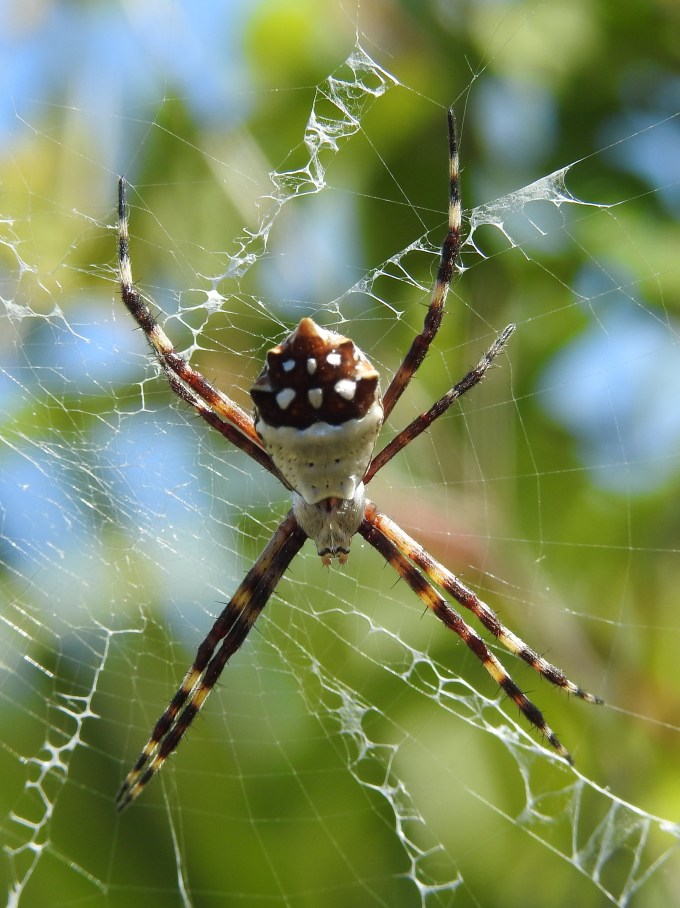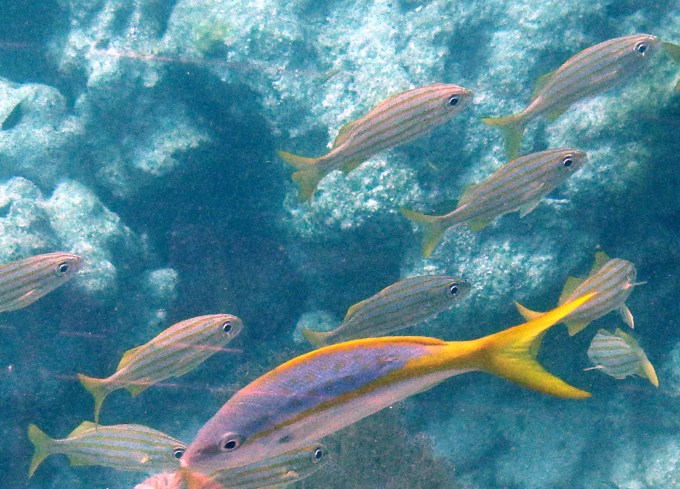In North America (north of Mexico), there are two regions that are classified as being subtropical: the Lower Rio Grande Valley (LRGV), about which I have written previously, and the southern tip of Florida, including the Keys. Both areas harbor not only a substantial number of plant species not found farther north, but also entire habitats unique in the U.S.: Tamaulipan thorn scrub in the LRGV, and tropical hardwood hammocks and pine rocklands in Florida. The LRGV also has a number of bird and mammal species not found elsewhere in the U.S., whereas Florida has just a few such birds and mammals, probably because of the difficulty of animals traversing the waters surrounding Florida, compared to the easy land access from Mexico. But, to compensate, Florida also has exceptionally diverse sea life because of its two coasts, and the presence of a large reef system in its southeast corner.

To explore this region, we stayed about a week each in three campgrounds, first a county park north of Miami, then a county park south of Miami, and finally an RV resort in the middle of the Florida Keys. From our northern base, we spent a day at The Nature Conservancy’s Blowing Rocks Preserve, which protects a swath of a narrow barrier island from the Atlantic Ocean to the bay side. The short trails provide access to the full cross-section of habitats from ocean to bay, and the extensive removal of alien plants has largely restored the original flora, few examples of which remain in the region. We next visited Fern Forest County Park in Broward Co., where about 34 ferns and fern allies have been found, an impressive total. From the trail system we found 20 of them, five of which were new for us! Best of all, we found the scarce Broad Halberd Fern, Tectaria heracleifolia, representing our 15th new vascular plant family this year! It was restricted to the short limestone outcrops (up to about a foot high) that marked the historical edges of a broad, sluggish flow of water from the Everglades to the Atlantic coast. Our activities north of Miami were rounded out by visits to several smaller areas, and a nice paddle on the Loxahatchee River in Jonathan Dickinson State Park (SP).

South of Miami we divided our time between pine rocklands and tropical hardwood hammocks, both rare habitats existing on very thin soils over limestone. The former have a sparse Slash Pine overstory, providing limited shade, with little mid-story, and a diverse shrubby understory a few feet high, under which are found interesting ferns and flowers. This habitat has been reduced to about 2% of its original extent in south Florida, the only place it occurs in North America. Long Pine Key in Everglades National Park is the largest remaining example of pine rockland, though we also saw it at four other locations.

Tropical hardwood hammocks are dense collections of a variety of Caribbean tree species of mostly modest height, with a sometimes dense mid-story of short trees and shrubs, and relatively little understory. Our favorite examples on the mainland were at Castellow Hammock Park and on the Deering Estate. Castellow Hammock had interesting limestone formations including a solution hole about ten feet deep and fifteen feet across, into which we scrambled and found two endangered species of ferns. The excellent natural areas at the Deering Estate are only accessible on guided tours, so we were incredibly lucky after the public tour to be taken on a private tour of a second area with a different plant assemblage.

While south of Miami, we were within the ranges of eight new vascular plant families, and found four of them, the species observed being: Florida Bitterbush, Picramnia pentandra; Graytwig, Schoepfia shreberi (thanks to a good tip from a ranger in Everglades NP); Pitted Stripeseed, Piriqueta cistoides; and Shoalgrass, Halodule wrightii. Shoalgrass is one of three species that forms seagrass beds in Florida, and we had tried for it three times previously without success, twice not even gaining access to the areas because of hurricane damage from Irma. But paddling to Chicken Key in Biscayne Bay, as suggested by the ranger at the Deering Estate, solved this problem.

Finally, we moved to the Florida Keys, staying in eastern Marathon, and paying about twice as much for our campsite as we ever have before (over $90 per night even with a weekly discount). All lodging/camping in the Keys is outrageously expensive except for camping in three state parks, which are booked far in advance. (There were four state park campgrounds before Irma, but it totally destroyed the Long Key SP campground.) Our first task was to try to record Pallas’ Mastiff Bat, Molossus molossus, a tropical species entering the U.S. only in a few places in the lower Florida Keys. We were quickly successful at the Marathon Community Park, the recordings closely resembling those we made in Panama in December. We now lack only 6 of 47 North American bats, but those six are real doozies.

Most of our time in the Keys was spent in tropical hardwood hammocks. Because there are so many similar species of trees, and so little was in fruit or flower, we depended heavily on identified trees along nature trails to save us time. The best location in this regard was fascinating Windley Key Fossil Reef Geologic SP, but Dagny Johnson Key Largo Hammock Botanical SP (record-holding name at 8 words!) and John Pennekamp Coral Reef SP were also good. We would walk the trails with our reference books, and read about each identified species, noting as many distinctive characteristics as we could. In some cases we could not find the identified plant (some possibly lost in Irma) or found it but did not feel we could independently identify it ourselves, but slowly a number of the characteristic species became familiar.

We spent two days in the pine rocklands on Big Pine and No Name Keys, hoping for two new families, but without success. It was very windy during our stay but one day was calm enough that we paddled out to Lignumvitae and Shell Keys, getting a fantastic look at a Nurse Shark on the bottom in just a few feet of water; it let us float right over it. We also took a glass-bottomed boat out to Molasses Reef from Pennekamp SP, on a day with excellent underwater visibility, and by studying photos Eileen took, added eleven fish to our admittedly very short fish life list!

One fish story to finish up. One night we ate dinner at the Islamorada Fish Company, right on the Gulf of Mexico. They have a small lagoon which connects directly to the gulf, and they toss shrimp in there occasionally to feed the wild fish that swim in. But we were not prepared to look up from our meal and see about ten fish swimming around, some around four feet long – our first Atlantic Tarpon!

So fun to read about and see photos of your expeditions…thanks for documenting your findings as modern day nature explorers!
LikeLike